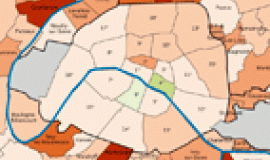
The demographic growth of Paris accelerated sharply during the period 2006-2010 (+ 0.7% per year) compared with the preceding period 1999-2006 (+0.4% per year). For the first time since the middle of the 1950s, the population increased more within Paris than in the inner or the outer suburbs.
This evolution showed a recentralisation of population growth right in the heart of the conurbation, in Paris itself, a trend which contrasted with other big conurbations in France. This development corresponded to a rise in the number of housing units but also to a fall in the number of those left vacant, also the sizes of households became more stable, which was a new phenomenon. The make-up of the population also evolved. The proportion of one-person households soared while that of families grew due to a high birth rate. So far as age goes there was little change. Despite the regional and national increase of the ageing population, the proportion of people of sixty or over increased very little in the capital. Socio-professional changes continued with the new development of a rising number of “executives and professionals” and a decline in numbers of “blue-collar workers” and “employees”. At the same time, the proportion of home-owners rose, even if rented housing remained by far the main type of housing in Paris.
Contents:
- The legal population on 1st January 2010
- Demographic and social characteristics
- Housing in the centre of the conurbation
- Employment and economic activities

